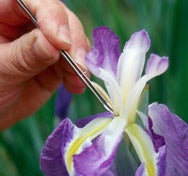Biodiversity Targets for the Future
In Sichuan province, China, there is an abundance of orchards but no bees.
“Thousands of people are hired to climb fruit trees and hand-pollinate the flowers with small brushes, because natural pollinators like bees have been killed by pesticides,” explained Jed Fuhrman, McCulloch-Crosby Chair in Marine Biology. Another vivid example of the loss of agricultural biodiversity is the colony collapse that has wiped out much of the bee population, which pollinates nearly one-third of crops in the United States.

An iris is pollinated by hand.
To lay the foundation for shared goals among nations in sustaining biodiversity, Fuhrman along with top experts in the field developed an international plan of action prioritizing “SMART” (specific, measurable, ambitious, realistic, and time-bound) targets for 2020. Their resulting report, “Ecosystem Services for 2020,” was featured in the Policy Forum section of Science magazine’s Oct., 15, 2010, issue.
This week, representatives from 193 countries associated with the Convention on Biological Diversity (CBD), a legally-binding treaty, are meeting in Nagoya, Aichi Prefecture, Japan. This report is being used as a foundation to review progress and set priorities among nations in sustaining Earth’s biodiversity. They hope to address the conservation of biodiversity; sustainable use of biodiversity; and fair and equitable sharing of the benefits arising from the use of genetic resources.
The targets of Ecosystem Services for 2020 are an improvement over the previously developed targets developed in 2010, but they could be strengthened, according to the report. “The 2010 targets were ambitious but vague and lacked specifics about where priorities lie,” Fuhrman said.
The report proposes consists of 20 targets classified into three categories: urgent priorities, provisional services and those that need to be completed in sequential order to make the plan work. The targets will help guide the development of international treaties among world nations.
“We are at a time when the rate of loss of species is similar to great extinctions in the fossil record — in some regions one-third to one-half of bird, amphibian, and mammal species may be lost in the coming century due to habitat destruction. At the current extinction rate, a third or more of all animal and plant species could be lost,” he said.
Fuhrman said that ecosystem services are not just about hugging trees. “We count on biodiversity for the basics that we take for granted — the water we drink, the nutrients that have to be recycled and the air that we breathe, including every other breath we take that is made possible by microorganisms in the ocean.”
Agricultural biodiversity is also key, according to Fuhrman. “Feed grains such as corn and wheat are important, but can be at risk due to our reliance on monoculture,” he said. “We now grow super crops for a better yield, but they are more susceptible to invasions and pests. Control of pests and emerging disease is an urgent priority that is aided greatly by protecting natural biodiversity.”
Many people understand the need for marine-protected areas for fish including the former massive cod fishery that collapsed largely from over fishing. Due to protections, the cod fishery appears to be slowly recovering.
“People talk today about the way things used to be, but of course nobody alive can remember how rich the natural world was a few centuries ago,” Fuhrman said. “Gone are the days when there were so many of the now extinct passenger pigeons that when they took flight the sky was black, and when early explorers could almost walk on the backs of sea turtles in parts of the Caribbean.”
The loss of ice in the Arctic is also well publicized. “People care about polar bears and baby walruses that are icons representing the loss of biodiversity,” Fuhrman said. “Yet, there are less well-known creatures, probably even including microorganisms, which we may never know are also being lost in the ocean. Human-caused acidification of the oceans is one of many threats.”
For those who believe that resources including oxygen, food and clean water will never be depleted, Fuhrman cites the analogy put forth by Stanford University biologists Anne and Paul Ehrlich demonstrates graphically how complex systems can fail catastrophically and unpredictably. In their analogy, an airplane symbolizes a complex ecosystem that depends on its many parts, with the various animals, plants and microbes represented by rivets or other components. If during a flight, the airplane’s rivets were to be removed randomly one by one, at what point could one predict the exact rivet that would literally be the last straw prior to disaster?
Aesthetic and religious values exist in tandem with ecosystem services. Fuhrman said that we can even apply dollar values to some purely aesthetic aspects of biodiversity. “The value of a home with a view of brownscape and factories is much less than one situated next to a coral reef or forest,” Fuhrman said.
“Biodiversity is not just about stuff that can be bought in grocery or department stores — it extends to people with spiritual values who have read in the Bible and other religious texts that we need to be good stewards of the land,” Fuhrman said.
If a dollar value had to be applied to biodiversity, Fuhrman said, humankind could not foot the bill. “The cost would be the size of the gross national product if we had to pay people to perform what nature does for us.”
Increases in world population bring ever-increasing human impacts, including global climate change, more land cultivation, and less area for biodiversity that affects the 20 biodiversity target goals. “We will have changes in environmental conditions that will result in adjustments to these goals in 20, 30 or 50 years from now — it’s a moving target and we must be vigilant,” Fuhrman said.
Other experts who contributed to the report include professors from Stanford University, Columbia University, and Arizona State University, among others.
To view Ecosystem Services 2020 report, go to www.sciencemag.org/cgi/content/full/330/6002/323